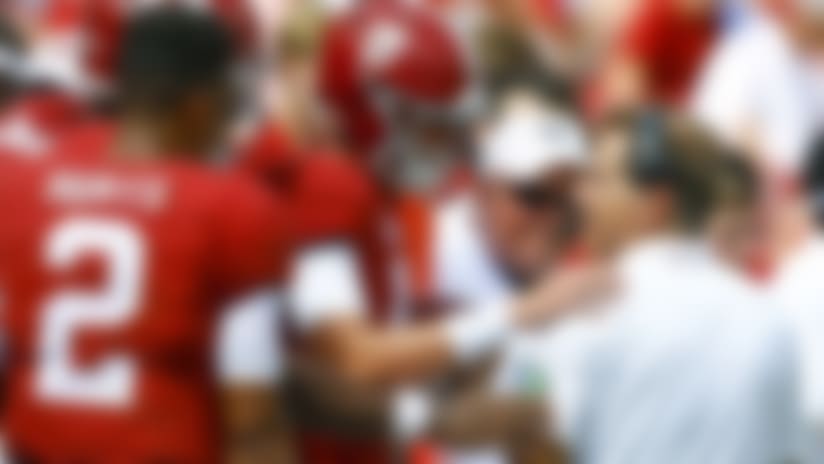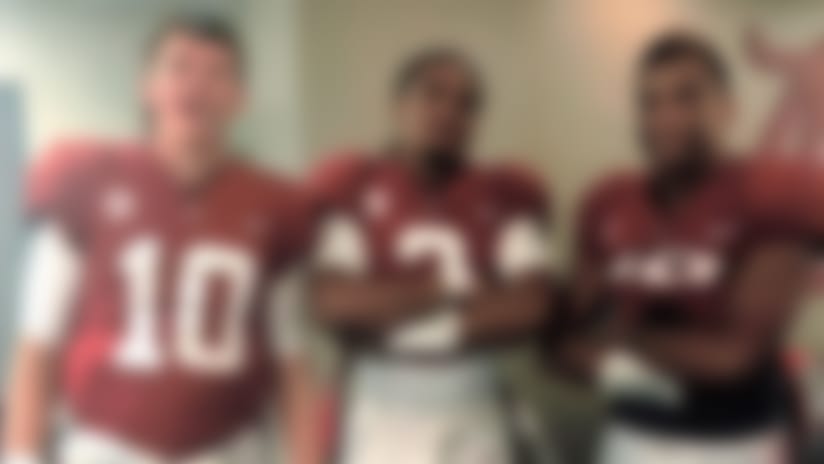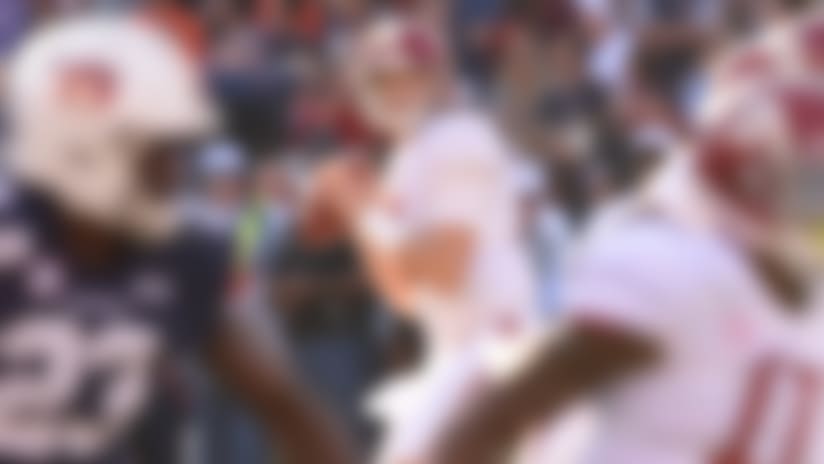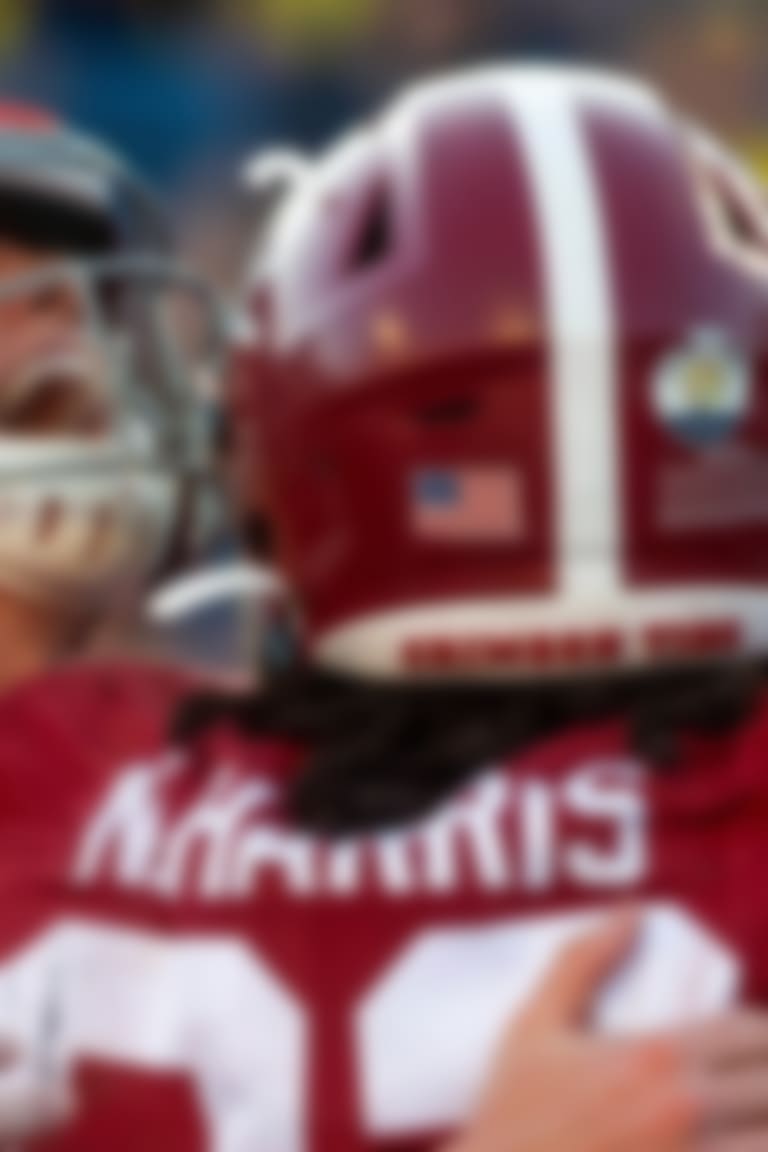Joker's wild: Why Alabama QB Mac Jones is getting the last laugh
Things weren’t always this easy for Mac Jones, who sat three years at Alabama waiting his turn. But the draft’s fastest-rising prospect who models his game and style after Tom Brady is about to get the last laugh. A fitting finish for the quarterback nicknamed the Joker.
TUSCALOOSA, Ala. — Richie Petitbon hadn’t even been born yet when Jack Nicholson kickstarted the modern cinematic depiction of the Joker as the formidable antagonist to Michael Keaton’s Batman in 1989. And when the grandson of the former NFL coach by the same name was 12 — the perfect demographic target for Heath Ledger’s reprisal of the frightening supervillain in The Dark Knight — it didn’t quite stick with Petitbon like the old-school Joker he knew from cartoons and comic books. In those mediums, the character could be more to Batman what Wile E. Coyote was to the Roadrunner – a determined but harmless foil. And it was that Joker, more clown than criminal, who Petitbon had in mind when he first coined Mac Jones’ enduring nickname.
It was the summer of 2017, and Jones, one of Alabama’s least-heralded recruits, didn’t seem to care one bit upon his arrival that he was buried on the quarterback depth chart behind incumbent starter Jalen Hurts and even the presumptive gem of his own signing class, five-star prize Tua Tagovailoa. He laughed a lot, and loudly. He’d sometimes break into spontaneous dance in the locker room.
A goof. A ham. A goofy ham.
“When he first came in, he was just so comfortable in his own skin, even though he didn’t really know many guys yet,” said Petitbon, an offensive lineman at Alabama during Jones’ first two years at Alabama before transferring to Illinois. “And he had this huge smile like the cartoon Joker. So, one day I just called him that, and it took off.”
Did it ever.
An animated demeanor, both on the field and off, marked Jones’ earliest impressions as the Crimson Tide’s scout-team quarterback. His enthusiasm was unbridled in a way that entertained teammates on the practice field, yet at the same time could occasionally raise the ire of fiery head coach Nick Saban.
Jones’ first iteration of the Joker brought more fun and inspiration to Alabama’s scout-team underlings than should ever be possible for a collection of bench players tasked as tackling dummies for the Crimson Tide’s vaunted, draft-bound starting defense. But Petitbon and many of Jones’ teammates also recognized the seeds of something bigger and more dangerous in the young Mac Jones. Something more cunning.
“The badass Joker was always in there somewhere,” said former UA receiver Mac Hereford.
Three years later, Jones’ final iteration of the Joker rained chaos on opposing teams. He terrorized defensive backs as the jovial maestro of the most prolific offense in Alabama history, leaving scoreboard destruction in his wake and laughing all the while. He was downright diabolical, if you ask the legions of college football fans who’ve had their fill of Alabama winning, the same way many NFL fans have tired of the Patriots dynasty. You know, the one led by Jones’ favorite quarterback: Tom Brady.
The cackling laugh that comes more from his belly than his throat became a little more sinister sounding. The fun-loving Jones hadn’t gone anywhere. But after he slashed through an undefeated season on the way to a national championship, the likes of Georgia, Auburn, Florida, Notre Dame and finally Ohio State were left to ask, “Why so serious?”
Jones never was a fan of superheroes or comic books as a kid, other than a mild fascination with Spiderman, and at first, he wasn’t thrilled when the nickname spread from teammates to social media and people he didn’t know.
“I saw the most recent (Joker movie), the violent one. I don’t want people to think I’m crazy like that,” Jones said of Hollywood’s latest Joker played by Joaquin Phoenix. “But it’s kind of who I am. I’m a guy who likes to laugh.”
The NFL took quick notice, and had to, because Jones only started one full season at the college level. They see a fun-loving quarterback who can also rip the heart out of opponents with the game on the line. He’s expected to be a first-round draft choice — maybe even as high as No. 3 overall where the San Francisco 49ers currently sit after their blockbuster trade with Miami two weeks ago — and there’s nothing funny to NFL clubs about that kind of investment.
This Joker is no joke.
Classic comic book characters carried traits that stood in conflict with one another, allowing their creators to traffic in suspense and mystery, generate unique storylines, and engender a broader consumer appeal. Superman had his Kryptonite, the Incredible Hulk had his softer side, and the Joker’s grin belied dastardly plans.
Descriptions of a young Mac Jones depict some contrasts, as well.
How could a kid have so much fun, wholly embracing the notion that sports are, at their core, performative art, and yet still be so deadly serious about winning and excelling?
Start, of course, with a keen sense of humor.
Dawn Collins, his fifth-grade teacher at The Bolles School in Jacksonville, Florida, recalls Jones’ ability to see more sophisticated humor than his fellow 10-year-olds could recognize. He’d tilt back his head to project his voice, open his mouth wide and yell, “Ha!” Sometimes the joke would still pass over the heads of his oblivious classmates; other times his laugh would serve as a prompter, and they’d catch onto the humor that Collins might have preferred them to have never noticed.
“He was so much fun, but he could laugh at the wrong time or out of turn,” Collins said. “I loved him, but sometimes I would have to give him the big eyes. There was a party going on in his head at all times.”
Jones’ smile could command attention, such that he got some work as a model as a child, his big grin and blonde hair combining to garner appearances – ever the showman — in various local commercials and pictorial advertisements.
And on the football field, wins followed his knack for fun and flair.
At 13, he once audibled to a fake spike in the final seconds of a youth game with his team trailing by three and within field goal range. With the defense assuming Jones was stopping the clock for the field goal unit, he instead lofted a deep touchdown pass for the win. The celebration, of course, went unchecked.
“That was Mac,” said Melvin Huff, one of his youth coaches in Jacksonville’s Mandarin Athletic Association.
Years later upon his arrival at Alabama, Jones’ jokester side made its appearances, even if it was just on the practice field. He’d find ways to needle Alabama’s starting defense as the scout-team quarterback, and in turn, goad fiery head coach Nick Saban as well. Once on what was supposed to be a Hail Mary drill, he instead threw a short checkdown pass to fellow scout-teamer Derek Kief, then took a lateral from Kief and ran 50 yards to the end zone. With no defender near him, he dove across the goal line with the ball extended – yet another Saban no-no — and finished with a spike.
The scout team exploded with excitement.
Saban exploded with something else.
The Joker strikes again.
“The straw hat flew, and he was so mad, he started running at me,” Jones said with a laugh. “For a second I thought he was going to tackle me.”
Just a few days removed from his second and final pro day workout, which he finished with the fun of catching a pass from running back Najee Harris, Jones sits in the comfort of a third-floor flat in Tuscaloosa’s new Westgate Condominiums. He reflects on some of the funniest moments of his four years – three spent in relative obscurity – on Alabama’s campus. With a balcony view of Bryant-Denny Stadium, his scout-team days provide much of the fodder.
The Crimson Tide defense Jones faced as the scout-team quarterback featured draft picks from top to bottom, including first-rounders Daron Payne, Rashaan Evans and Minkah Fitzpatrick. Eventual No. 3 overall pick Quinnen Williams was a backup. The talent advantage over the scout team was beyond unfair, and, of course, they’d been game-planning to recognize and stop the very plays Jones was being asked to run. He wasn’t about to give them any more advantage than they already had.
Not even anticipating the snap count.
The Joker would occasionally blow Saban’s stack in practice with a hard count to draw the starting defense offsides. A clever means of keeping them honest, perhaps, but to Saban, it was simply a wasted rep and a waste of 30 seconds to reset.
“There are all sorts of little tricks that made (scout team) more fun,” Jones said, “but it would piss off the defense at the same time.”
If the UA football program had to buy more balls than usual in 2017, the scuffs Jones put on them would’ve been the reason. Rocketing spirals so far out of bounds in practice that they’d hit the brick façade of the Mal Moore Athletic Complex will do that. Saban would want balls thrown to certain scout-team receivers whether they were open or not, to give the defense a look at the play to expect from an upcoming opponent. Jones, who was redshirting his first year on campus, would have none of it.
“He just refused to throw a ball he wouldn’t have thrown in a game,” said former Alabama quarterback Kyle Edwards. “When he realized the play was dead, and against our defense that happened a lot, Mac would roll out and chuck the ball 20 yards out of bounds, into the brick wall, into the parking lot. Coach Saban would get furious, but that was Mac being competitive.”
Joe Dickinson, a former Oklahoma assistant and Jones’ longtime private coach, believes he might be a bit to blame. Dickinson, 64, was on the OU staff when Troy Aikman was a scout-team freshman there early in 1984, prior to his transfer to UCLA. Aikman displayed the same refusal to feed the Sooners’ starting defense cheap interceptions, a story Dickinson had imparted to Jones before he ever got to Alabama.
The Joker, however, was largely impervious to Saban’s bluster. Much credit for that goes to his high school coach, the late Corky Rogers of The Bolles School. Rogers, who passed away last year, was to Florida high school football what Saban is to the college game. His teams won a Florida-record 10 state championships, never enduring a losing season in 45 years as a head coach. He drove players hard with an old-school style that evolved slowly, tolerated no nonsense, and would chide Jones for his use of social media to enhance his recruitment.
During Jones’ senior year, Rogers was so upset by a bad Thursday practice, he reconvened the team Friday morning for a practice on game day. A tongue-lashing from Saban can be a jarring experience for incoming Alabama freshmen, but thanks to his exposure to Rogers’ ire, Jones arrived at UA with thick skin.
“I was definitely used to it,” Jones said.
Jones’ passion for the game had no bounds. He’d butt helmets with youth-ball teammates to hype himself up before games — the skinny quarterback who didn’t care that helmet-butting was more of a lineman’s ritual. Jones could barely contain himself when he’d throw a touchdown pass, pointing skyward or ginning up the crowd.
But as much fun as the Joker had, his emotions also could flash anger – always self-directed – when he made mistakes.
“He did have a little history of struggling with his emotions because he’s a passionate kid,” said Mandarin Tigers coach Eric Yost. “He was never a negative kid. But when things didn’t go his way, he could have a meltdown for a couple plays. And then he’d shake it off and throw a 40-yard rope. One play you’d be mad at him, and the next you’re saying, ‘OK, that’s why he’s our guy.'”
It was this fiery Jones, beneath that happy-go-lucky surface, who understood that all the fun was in the winning. He was once ejected as the coach of an intramural sorority flag football team but contends with a broad smile that it was a different coach who made the thumb-worthy remarks to officials. Jones, competitive to the last, continued calling plays from his car, via cell phone, and the Zeta Tau Alpha team eventually won the championship.
“If you stole it from Mac in basketball, he’d just as soon tackle you than give you a layup on the other end,” said Gordon Jones, his father.
At Alabama, however, the harsh reality for scout offenses is that the vast majority of plays are abject failures. Blocks can’t be sustained, receivers can’t get open, and quarterbacks are sitting ducks. Not an optimum combination for a guy who could briefly lose his temper over a bad play. Saban had his own nickname for Jones, and it wasn’t the Joker. He called him “McEnroe” for his first couple of years on campus, a reference to tennis legend John McEnroe’s reputation for brief fits of anger and bad body language.
“You gonna slam your racket today?” Saban would ask.
For a kid named Mac, whose father was a pro tennis player, it was a pretty clever nickname. But it wasn’t the one that stuck.
As much as Alabama freshmen typically fear Saban’s wrath, Jones would be Jones. That meant having fun and competing as though the scout team was playing for a national championship, even if the true role was something far less glorious. Saban’s well-known temper didn’t bother the quarterback in part because the McEnroe in him was always more self-critical than anything Saban could dish out.
“If I missed a throw or threw an interception, it’d be hard to move on from it. I’d complain about how I suck,” Jones said. “But the next day would be better. I’d just have to get that out and say it, that I suck, but I’d always come back [stronger] the next day.”
There are various junctures across Jones’ development that people close to him cite as a turning point in maturing his approach and sharpening his edge, but the impact was more collective.
The three-year wait he endured to become Alabama’s starter was certainly a lesson in perseverance. During special teams periods in Alabama’s indoor practice facility, while Hurts and Tagovailoa worked with Alabama’s offensive coordinators, Saban would have Jones stand in the middle of the field and throw simulated punts so that when the kicks hit the facility’s ceiling, the returner could still get a rep. It could be dangerous work, with the coverage unit sprinting downfield in his path, and a maddening assignment that would make any quarterback wonder if he’d ever be trusted to start.
“I’d get trampled. I’d try to turn around or get away and someone would run into me. I’d get smoked,” Jones recalled. “I hated when it rained, because I knew I’d have to throw punts.”
Off the field, there was an arrest for DUI during his redshirt year in 2017 that made Jones re-evaluate his priorities. His father had never been a drinker, even in college, and Mac knew his dad’s disappointment would be profound.”I focused on what was important to me, which was football.” Jones said. “On nights when people would be going out, I would go to the indoor [football facility], throw into a net, watch film by myself. I’d usually close all the doors.”
Added Hereford: “For me, that (DUI) incident was a transitional event for Mac. … He didn’t go out anymore. He locked in and put his head down. He was balling before, but after that it was more of an ‘I’m kicking ass and taking names’ kind of vibe.”
On the field, a 48-45 loss to Auburn in 2019 — just two weeks after he’d taken over the starting job when Tagovailoa dislocated his hip — was a valuable lesson, as well. In that game, Jones threw two interceptions that were returned for touchdowns; the loss ended Alabama’s slim hopes of reaching the College Football Playoff and gave his team’s archrival an offseason to rejoice. That he also threw four touchdown passes, two of which followed each pick-six to put Alabama back ahead on the scoreboard, inspired confidence in teammates for the long term, but mattered less to Jones.
“I’ll always look at it as just an L,” he said.
By then, however, any outbursts of frustration had given way to the more even-keeled demeanor winning quarterbacks maintain through adversity. McEnroe was gone for good.
“I saw that go away after the Auburn game (junior year). He switched gears and made a commitment that he was going to do whatever it took, and he went on a different mission,” said his mother, Holly. “Some different gears kicked in, and I never saw that Mac again.”
Dickinson sips on a breakfast juice on the bank of the Black Warrior River in Tuscaloosa, heels his dog, and takes in the water view. Having worked with Jones for 10 years, he’s seen various stages of his development. There’s a bond between them that carries a lot of trust; when Jones finished interviews with NFL clubs at about 11 p.m. during the Senior Bowl week in Mobile, he then huddled with Dickinson via Zoom until 1 a.m. before going to bed.
Dickinson is in town this day to train Jones for his pro day, but it’s a training session from more than a year earlier that has his attention.
“February 18,” he says. “[I] remember it like it was yesterday.”
At Jones’ request, Dickinson made a trip to Tuscaloosa on Feb. 18, 2020, to work with the quarterback on his deep ball. In the same indoor facility where Dickinson conducted Jones’ two pro day workouts last month, he watched the quarterback launch about 150 high-arching bombs to DeVonta Smith and Jaylen Waddle that February day – more than twice as many throws as in a typical offseason throwing session. Jones began to dial in the right timing and trajectory to connect rainbow throws to the most talented receiving tandem in the college game. Then Dickinson took him into the film room and pulled up video of Joe Burrow’s 2019 national championship season at LSU.
“Now tell me what Burrow is doing that you can’t do,” Dickinson.
“Nothing,” Jones replied after the film session.
“Right,” Dickinson replied. “Nothing. You’ve got those two receivers we just threw to who can get open against anybody in the country. If you can hit them deep, you might mess around and win the Heisman.”
It was as much of a breakthrough as an offseason workout can be. Still, Jones’ transformation into the diabolical Joker, replete with 41 touchdown passes, an NCAA-record 77.4 percent completion rate, and the highest college QBR (96.1) in the 17-year history of the measurement, was forged in a near-maniacal work ethic that bubbled beneath the surface of his more emotional, fun-loving exterior.
It was no joke when Edwards found Jones, just a day after Alabama’s national championship win over Georgia his freshman year, breaking down film of the game early in the morning even though both Hurts and Tagovailoa would be returning the next year.
It was no joke when he’d call Hereford to catch balls in the indoor facility late at night, with nobody else around, to work on his game. He could pick the oddest times to log practice time on his own – once, even, right after the team’s annual banquet.
Yes, Jones could have fun, but he was at Alabama to win the quarterback job, not spend a career commanding the scout team.
From a preparation standpoint, he took after Tom Brady in all sorts of ways. He’s studied Brady’s technique right down to the action of his non-throwing hand. Alabama trainer Bobby Feeback always taped Jones’ ankles Brady-style – Jones called it “the Brady spat” — over the top of the cleats. When he threw on his own, he’d often do it in a helmet and shoulder pads, as Brady prefers. UA helmets are only issued for practices and games, but Jones had a workaround – he’d use his high school helmet from Bolles. He even gave some consideration to donning a helmet and shoulder pads for his pro day workouts.
Jones also lifted some preparation tips from the Brady documentary “Tom vs. Time.” He sees his own experience at Alabama not unlike Brady’s at Michigan – an underappreciated backup behind a more heralded starter.
“At Michigan, they said he wasn’t going to play because of Drew Henson. They said he wasn’t going to play in the NFL. I like his story more than his play,” Jones said. “Obviously his play is great and I model some of my game after him, with his footwork and how he prepares, but he had a chip on his shoulder, the same one I have.”
For Saban, Jones’ decision to stay at Alabama rather than transferring set up the growth and maturity needed for his breakout season in 2020. Now, with NFL clubs lining up at the top of the draft to select a quarterback, Jones could hear his name called awfully early on April 29.
“(NFL teams) are going to fall in love with a guy who is really a hard worker, a good leader, and the guy is very committed to being the best player he can be,” Saban told NFL Network following Jones’ first pro day workout. “He’s smart, he’s going to know the offense inside and out, he makes quick decisions, has great judgment, and he’s very accurate with the ball. I think the combination of those things is going to make him a fine player at the next level.”
Perhaps it was fitting that Jones took over Alabama’s starting job just as Joaquin Phoenix’s Joker persona was frightening theatergoers like never before. The deep ball Jones honed in the offseason devastated opposing defenses, particularly those that chose to walk up a safety to help control Alabama running back Najee Harris. Alabama receivers caught 11 touchdowns of 30 yards or more in the regular season, and while not all were thrown over the top of the defense, Jones’ proclivity for connecting on deep balls was uncanny. He completed a staggering 64 percent of throws that traveled 30 or more yards in the air.
Naturally, nobody had more fun scoring those touchdowns than Jones. Holding for extra points, normally a job for the backup but one Jones didn’t relinquish as a starter, helped keep his excitement under control.
“If he didn’t have to do that, he’d be turning flips,” Huff said. “Nobody can celebrate a touchdown harder than Mac Jones.”
The skill set Jones will bring to the NFL might not be as athletically dynamic as his predecessors, Hurts and Tagovailoa, but scouts see a combination of adequate arm strength, very good accuracy and near-impeccable decision-making.
“All the guy does is find the right man and put the ball on the money,” said a scout for an NFC team. “He only showed it for one year, but that’s not much of a concern anymore. (Mitchell) Trubisky only lit it up for a year. Kyler Murray, Joe Burrow, it’s not so uncommon now.”
Critics of Jones’ NFL potential point to the vast talent around him at Alabama and wonder if he’ll struggle if drafted by a team with a weak offensive line or a receiving corps that struggles to get open. To be sure, the Crimson Tide’s offensive line won the Joe Moore Award as the nation’s best, with first-round-caliber receivers Smith and Waddle at his disposal, and another potential first-rounder in Harris. His pass protection was good enough to often let Smith and Waddle put double moves on defensive backs, which helped get them open for some of those long completions.
Nevertheless, the Joker still had to hit them in stride, which he did with remarkable consistency.
Asked about the strength of his line and his deep cast of weapons at the Senior Bowl in January, Jones’ response couldn’t have been more succinct.
“The tape is the tape,” he said. “I did what I did.”
For decades dating back to the 1950s, the Joker character was softened and tamed by a regulatory body known as the Comics Code Authority. The CCA was founded within the comic book industry in response to public outcry and government scrutiny about the appropriateness of its content for children. Comic books weren’t sold without the CCA stamp, and Batman’s green-haired rival was reduced to a folly of a nemesis. The Batman television series of the late 1960s followed suit, with actor Cesar Romero clowning his way through devious plots against Adam West’s Batman that were more corny than cunning.
Like Jones at one time, nobody took the Joker too seriously. But like Jones, the character came of age as a feared menace.
In the 1970s and 80s, kids who’d been subjected to sanitized supervillains became parents themselves. Comic books began losing a battle with television for the attention of American youth, and harder-edged characters began to look more like the medium’s only path of survival. The Comics Code Authority’s doctrine was relaxed and revised, with DC Comics – which counted the Joker among its properties – demanding more creative freedom for its story boards.
The Joker was unleashed.
When Mac Jones came off the leash, he terrorized the Southeastern Conference like his own personal Gotham – with Batman nowhere in sight.
For Hereford, Jones’ ascent to a feared Joker was marked by a crushing hit he absorbed in a 2019 Citrus Bowl win over Michigan that foretold his dominance in 2020. Defensive end Aidan Hutchinson, flagged for roughing the passer on the play, leveraged his body weight to drive Jones’ head into the turf.
One of Jones’ molars split into pieces. He was spitting blood and chunks of his tooth. A commemorative jersey patch was half torn by Hutchinson’s hit, and Jones ripped it off and tossed it to the turf.
Trainers stepped toward him; Jones yelled for them to stay off the field, and he didn’t miss a play.
“I thought he was dead,” Hereford said. “But he’d waited three years to get hit like that, and everyone on the sideline could relate. That was the Joker. You can’t kill him. He looks over like, ‘Let’s go, what’s the next play?’ It was legendary.”
Follow Chase Goodbread on Twitter.
Source: Read Full Article






